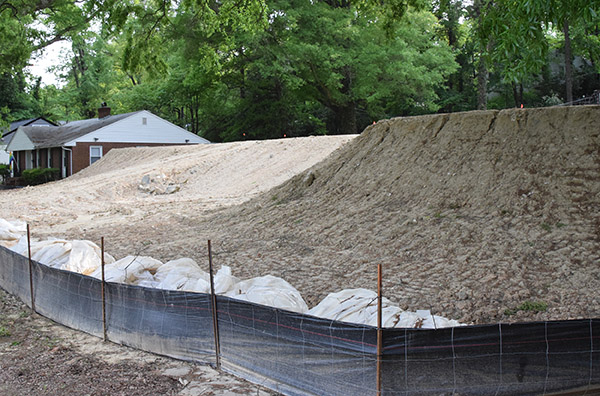The neighbors call it “Mount Latham” and it’s not a compliment.
City Councilmember Justin Outling who lives a few blocks away in Fisher Park said he was surprised at how visible it was from Wendover Avenue.
What it is, is a building site for two houses in the 100 block of Latham Road which is only half a block north of Wendover Avenue across the street from Latham Park which is known for flooding.
The reason it is Mount Latham is that the site was raised above the 100 year flood plain in order to comply with Federal Emergency Management Agency (FEMA) regulations.
Water Resources Engineering Manager Virginia Spillman has become the point person for the city on the project, more or less by default. There was a rumor that a stop work order had been issued by the city, but Spillman said that the developer had a valid building permit and had complied with all applicable city, state and federal regulations, so there was no rationale for a stop work order.
Spillman said that because it was only two lots, the houses don’t come under the same storm water management plans that would apply to a larger development. But she added that it was the responsibility of the developer to prevent storm water from running on to adjacent lots.
Spillman said “I’m meeting with the developer to see if there is anything that can be done to help the neighborhood, to consider the options available.”
She said, “It’s a tough situation. They don’t like the way it looks.”
One of the aspects of the project that makes it look bad is the new elevation of the lot, and Spillman said that the developer had chosen to raise the lot to that height so that the homeowner would not be required to have flood insurance. She added that as long as the lot met the height requirements above the 100 year flood plain there were no restrictions on building. She said, “These guys are meeting all the requirements that they have to comply with.”
Another question neighbors had was if a retaining wall had to be built around the raised lot. Spillman said that a retaining wall was not required and whether or not one was built was up to the developer.
Outling said that he was surprised that there were not rules and regulations in place to prevent raising a lot in a neighborhood like that. He said, “That’s the reason you have a planning department so something like that doesn’t happen.”
But Outling added, “I see my role as making sure that it doesn’t happen again.”


I believe the City should have determined whether the placement of engineered fill on the lots has the potential to raise the flood elevation on the adjoining properties. This is a calculation that an engineer would be able to make. If the flood height on the adjoining properties is greater after the construction that before, the City should not have allowed the lots to be filled. This is a basic tenant of the FEMA Flood Insurance program that the City should be aware of.